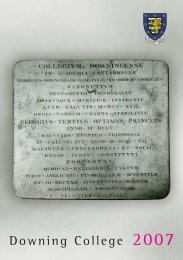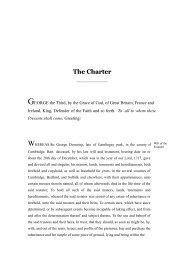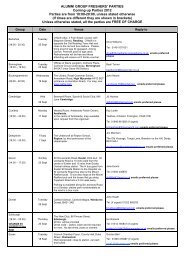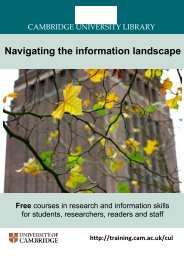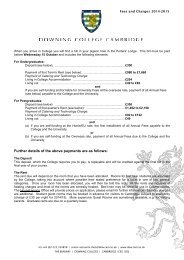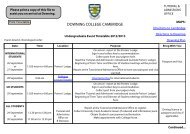veterinary students handbook the first two years - Downing College
veterinary students handbook the first two years - Downing College
veterinary students handbook the first two years - Downing College
Create successful ePaper yourself
Turn your PDF publications into a flip-book with our unique Google optimized e-Paper software.
Your Director of Studies will be able to help you make a decision about what to take in <strong>the</strong> third year,<br />
and <strong>the</strong>re will be an opportunity for you to attend a Subjects Fair in March 2014 where <strong>the</strong> various<br />
course organisers will set up <strong>the</strong>ir stalls and explain what <strong>the</strong>y offer.<br />
The Clinical Veterinary Curriculum<br />
The clinical training is an integrated core teaching programme based on separate but related courses<br />
given over <strong>the</strong> <strong>first</strong> six terms of <strong>the</strong> three clinical <strong>years</strong>. Some courses have a body systems basis<br />
(alimentary) and some a discipline (anaes<strong>the</strong>sia) or species basis (equine). Alongside this <strong>the</strong>re is<br />
small group practical teaching on a rotational basis dealing with such things as clinical methods, post<br />
mortem work, radiography, clinical pathology and gynaecology. Regular formal assessment takes <strong>the</strong><br />
form of course exams spread throughout <strong>the</strong> five terms, <strong>the</strong> aim being to encourage steady work and<br />
personal development.<br />
There is a proportion of elective work in <strong>the</strong> clinical course with fourth year <strong>veterinary</strong> public health<br />
assignments and sixth year clinical electives, when <strong>students</strong> can choose areas of interest to study in<br />
greater depth than in <strong>the</strong> core curriculum.<br />
The final three terms are essentially lecture-free and consist of small group rotational work through<br />
<strong>the</strong> clinics of <strong>the</strong> Department of Veterinary Medicine. There is an increasing emphasis on <strong>students</strong><br />
taking responsibility for <strong>the</strong>ir own learning and development, with case and client management under<br />
supervision.<br />
Continuous assessment forms an important part of this rotational work and contributes marks towards<br />
<strong>the</strong> Final Veterinary Exam Part (III) that completes <strong>the</strong> course at <strong>the</strong> end of <strong>the</strong> sixth term. Students,<br />
on passing this exam, can <strong>the</strong>n be registered as members of <strong>the</strong> Royal <strong>College</strong> of Veterinary<br />
Surgeons.<br />
Throughout <strong>the</strong> clinical <strong>years</strong> <strong>students</strong> undertake a minimum of 26 weeks extra mural training in<br />
<strong>veterinary</strong> practices and o<strong>the</strong>r establishments, sometimes with overseas experience.<br />
The formal objectives of <strong>the</strong> clinical course are set out below, and <strong>the</strong> foundations for many of <strong>the</strong>se<br />
are laid in <strong>the</strong> pre-clinical course.<br />
Programme outcomes<br />
The clinical <strong>veterinary</strong> course occupies <strong>the</strong> final 9 terms of <strong>the</strong> 18 term <strong>veterinary</strong> course at<br />
Cambridge.<br />
On completion of <strong>the</strong> <strong>first</strong> level of <strong>the</strong> clinical course (Final Vet MB Part I & Part II), at <strong>the</strong><br />
beginning of <strong>the</strong> 6 th term of <strong>the</strong> clinical course (12 th term of whole course), <strong>students</strong> should have:<br />
Knowledge and understanding<br />
• a knowledge of <strong>the</strong> structure and function of healthy animals, which will allow <strong>students</strong> to<br />
recognise and understand abnormal and disease states of body systems;<br />
• a sympa<strong>the</strong>tic understanding of <strong>the</strong> handling, management and nutrition of domesticated<br />
animals and of <strong>the</strong>ir needs in health and disease;<br />
• a knowledge of <strong>the</strong> principles and practice of preventive <strong>veterinary</strong> medicine and <strong>veterinary</strong><br />
public health;<br />
• a knowledge of reproductive physiology and genetics sufficient to understand breeding<br />
management in large and small animals;<br />
15



